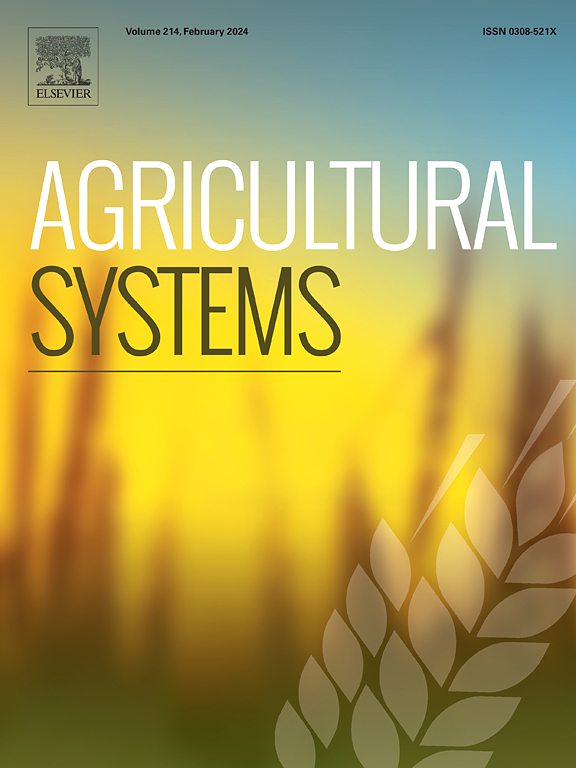Vulnerability of agroecosystems to climate change in the Sahel
IF 6.1
1区 农林科学
Q1 AGRICULTURE, MULTIDISCIPLINARY
引用次数: 0
Abstract
CONTEXT
Climate change is influencing the integrity of agroecosystems, with negative impacts on food security, by modifying the crop types used and by altering the plant physiological and biochemical processes that sustain ecosystem service provisioning. In this new environmental context, understanding the spatial patterns and dynamics of climate change agroecosystems face is important for effective conservation and management.
OBJECTIVE
This study evaluates agroecosystems vulnerability to climate change through exposure, sensitivity, and adaptive capacity.
METHODS
The Shannon Entropy Weight method was employed to estimate the relative weights for individual indicators across the categories of exposure, sensitivity, and adaptive capacity. Indicators of exposure included change in temperature, precipitation variability, and natural disasters. Sensitivity was measured using crop production, livestock density, and distance from deforestation. Adaptive capacity was assessed by evaluating sustainable livelihood assets. These components were integrated into a vulnerability index to inform targeted management approaches.
RESULTS AND CONCLUSION
Ethiopia was identified as the country with the highest overall vulnerability, closely followed by Niger and Nigeria. These countries exhibited the highest vulnerability scores in the study, with Ethiopia showing the most pronounced levels of vulnerability.
SIGNIFICANCE
Mapping vulnerability assessment informs sustainable agroecosystems in climate change adaptation.

萨赫勒地区农业生态系统对气候变化的脆弱性
气候变化正在影响农业生态系统的完整性,通过改变所使用的作物类型和改变维持生态系统服务供应的植物生理生化过程,对粮食安全产生负面影响。在这种新的环境背景下,了解农业生态系统面临的气候变化的空间格局和动态对有效的保护和管理具有重要意义。目的通过暴露度、敏感性和适应能力评估农业生态系统对气候变化的脆弱性。方法采用香农熵权法估计暴露、敏感性和适应能力类别中各指标的相对权重。暴露的指标包括温度变化、降水变异性和自然灾害。灵敏度是通过作物产量、牲畜密度和距离森林砍伐的距离来衡量的。通过评估可持续生计资产来评估适应能力。这些组成部分被整合到一个漏洞指数中,为有针对性的管理方法提供信息。结果与结论埃塞俄比亚是总体脆弱性最高的国家,紧随其后的是尼日尔和尼日利亚。这些国家在研究中表现出最高的脆弱性得分,其中埃塞俄比亚表现出最明显的脆弱性水平。测绘脆弱性评估为可持续农业生态系统适应气候变化提供信息。
本文章由计算机程序翻译,如有差异,请以英文原文为准。
求助全文
约1分钟内获得全文
求助全文
来源期刊

Agricultural Systems
农林科学-农业综合
CiteScore
13.30
自引率
7.60%
发文量
174
审稿时长
30 days
期刊介绍:
Agricultural Systems is an international journal that deals with interactions - among the components of agricultural systems, among hierarchical levels of agricultural systems, between agricultural and other land use systems, and between agricultural systems and their natural, social and economic environments.
The scope includes the development and application of systems analysis methodologies in the following areas:
Systems approaches in the sustainable intensification of agriculture; pathways for sustainable intensification; crop-livestock integration; farm-level resource allocation; quantification of benefits and trade-offs at farm to landscape levels; integrative, participatory and dynamic modelling approaches for qualitative and quantitative assessments of agricultural systems and decision making;
The interactions between agricultural and non-agricultural landscapes; the multiple services of agricultural systems; food security and the environment;
Global change and adaptation science; transformational adaptations as driven by changes in climate, policy, values and attitudes influencing the design of farming systems;
Development and application of farming systems design tools and methods for impact, scenario and case study analysis; managing the complexities of dynamic agricultural systems; innovation systems and multi stakeholder arrangements that support or promote change and (or) inform policy decisions.
 求助内容:
求助内容: 应助结果提醒方式:
应助结果提醒方式:


